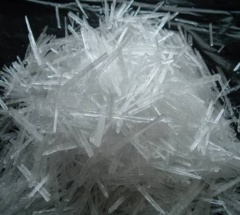Difference between revisions of "Menthol"
(→Application) |
(→Description) |
||
| Line 12: | Line 12: | ||
Menthol's ability to chemically trigger the cold-sensitive TRPM8 receptors in the skin is responsible for the well-known cooling sensation it provokes when inhaled, eaten, or applied to the skin. In this sense, it is similar to capsaicin, the chemical responsible for the spiciness of hot chilis (which stimulates heat sensors, also without causing an actual change in temperature).<br><br> | Menthol's ability to chemically trigger the cold-sensitive TRPM8 receptors in the skin is responsible for the well-known cooling sensation it provokes when inhaled, eaten, or applied to the skin. In this sense, it is similar to capsaicin, the chemical responsible for the spiciness of hot chilis (which stimulates heat sensors, also without causing an actual change in temperature).<br><br> | ||
| − | Menthol's analgesic properties are mediated through a selective activation of κ-opioid receptors. Menthol also blocks voltage-sensitive sodium channels, reducing neural activity that may stimulate muscles. Menthol also enhances the efficacy of ibuprofen in topical applications via vasodilation, which reduces skin barrier function. | + | Menthol's analgesic properties are mediated through a selective activation of κ-opioid receptors. Menthol also blocks voltage-sensitive sodium channels, reducing neural activity that may stimulate muscles. Menthol also enhances the efficacy of ibuprofen in topical applications via vasodilation, which reduces skin barrier function.<br><br> |
Derivation: by freezing from peppermint oil, by hydrogenation of thymol.<br> | Derivation: by freezing from peppermint oil, by hydrogenation of thymol.<br> | ||
| + | |||
==Application== | ==Application== | ||
Use: perfumery, cigarettes, liqueurs, flavouring agent, chewing gum, chest rubs, cough drops.<br> | Use: perfumery, cigarettes, liqueurs, flavouring agent, chewing gum, chest rubs, cough drops.<br> | ||
Revision as of 09:24, 9 August 2013
| Infobox on Menthol | |
|---|---|
| Example of Menthol |  |
| Facts | |
| Origin | Brazil (natural product), Japan |
| Stowage factor (in m3/t) | - |
| Humidity / moisture | - |
| Ventilation | - |
| Risk factors | - |
Menthol
Description
Menthol is an organic compound made synthetically or obtained from cornmint, peppermint or other mint oils. It is a waxy, crystalline substance, clear or white in colour, which is solid at room temperature and melts slightly above. Menthol has local anesthetic and counterirritant qualities, and it is widely used to relieve minor throat irritation. Menthol also acts as a weak kappa opioid receptor agonist.
Menthol's ability to chemically trigger the cold-sensitive TRPM8 receptors in the skin is responsible for the well-known cooling sensation it provokes when inhaled, eaten, or applied to the skin. In this sense, it is similar to capsaicin, the chemical responsible for the spiciness of hot chilis (which stimulates heat sensors, also without causing an actual change in temperature).
Menthol's analgesic properties are mediated through a selective activation of κ-opioid receptors. Menthol also blocks voltage-sensitive sodium channels, reducing neural activity that may stimulate muscles. Menthol also enhances the efficacy of ibuprofen in topical applications via vasodilation, which reduces skin barrier function.
Derivation: by freezing from peppermint oil, by hydrogenation of thymol.
Application
Use: perfumery, cigarettes, liqueurs, flavouring agent, chewing gum, chest rubs, cough drops.
Shipment / Storage
Usually shipped as white crystals in tins inside cases or in drums. Menthol is slightly soluble in water and melts between 41°C and 43°C.
As this commodity is extremely volatile, the packing must be airtight. Should be preserved at a temperature not above 30°C. When the temperature rises, menthol will vaporize, escape from the container and a part will condense on the outside in the form of a thin sheet of menthol (sublimation). The escape of vapour may give rise to a loss in weight. When volatilised it cakes and may depreciate in value.
When stored at tropical temperatures will clog together. The process is one of ‘sintering’, whereby the crystals, at temperatures approaching the melting point, reform themselves into a more compact state, without any actual liquefaction. Menthol and related compounds are particularly prone to this. Due to the low melting point of menthol this effect will show itself even in temperate climates if the storage is prolonged.
Sound menthol may be tested by dropping an iron rod into the contents and when drawn up again the menthol should not stick to the rod. Weighing the container is the only way to ascertain the shortage due to sublimation of the menthol.
Risk factors
Hazard: irritant to mucous membranes on inhalation.











